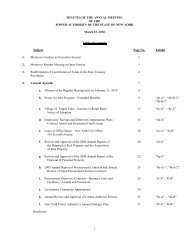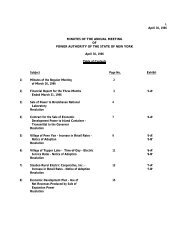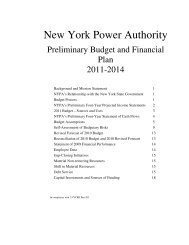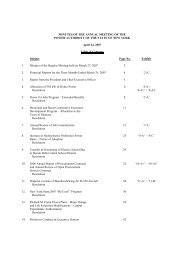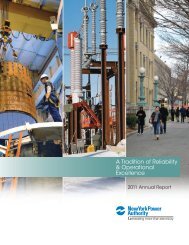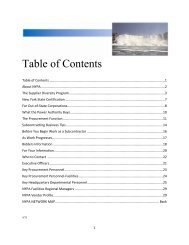July (pdf) - New York Power Authority
July (pdf) - New York Power Authority
July (pdf) - New York Power Authority
Create successful ePaper yourself
Turn your PDF publications into a flip-book with our unique Google optimized e-Paper software.
withdrawn by the <strong>Authority</strong> on August 1, 2011. On June 29, 2011, the <strong>Authority</strong>’s Trustees authorized<br />
the use of revenues from the sales of such power into the wholesale market or, as necessary, internal<br />
funds to fund the residential consumer discount program for its first six months.<br />
(5) Chapter 436 of the Laws of 2010 established a Western <strong>New</strong> <strong>York</strong> Economic Development Fund<br />
Benefit program and authorized the <strong>Authority</strong> to fund the program from net earnings from the <strong>Authority</strong>’s<br />
sale of unallocated, relinquished, and withdrawn Expansion <strong>Power</strong> and Replacement <strong>Power</strong> into the<br />
wholesale market. Net earnings are defined as any excess revenues earned from such power allocated to<br />
the wholesale market over the revenues that would have been received had the power been sold at the<br />
Expansion <strong>Power</strong> and Replacement <strong>Power</strong> rates. Proceeds from the fund may be used to support eligible<br />
projects undertaken within a 30-mile radius of the Niagara Project that qualify under applicable criteria.<br />
The law authorizes the <strong>Authority</strong> to administer this new program with assistance from public and private<br />
entities. <strong>Authority</strong> revenues for the fund could range between [$2] million and [$10] million per year.<br />
(6) In 1997 and subsequent years, legislation was enacted into <strong>New</strong> <strong>York</strong> law which authorized the<br />
<strong>Power</strong> for Jobs program (the “PFJ Program”) to make available low-cost electric power to businesses,<br />
small businesses, and not-for-profit organizations. Under the PFJ Program, EDPAB recommends for<br />
<strong>Authority</strong> approval allocations to eligible recipients of power from power purchased by the <strong>Authority</strong><br />
through a competitive procurement process and power from other sources. The <strong>Authority</strong> also is authorized<br />
to provide power through an alternate method to the competitive procurement process if the cost of the power<br />
through the alternate method is lower than the cost of power available through a competitive procurement<br />
process, provided that the use of power from <strong>Authority</strong> sources does not reduce the availability of, or cause<br />
an increase in the price of, power provided by the <strong>Authority</strong> for any other program. If the <strong>Authority</strong> decides to<br />
not make power available to an entity whose allocation has been recommended by EDPAB, the <strong>Authority</strong><br />
must explain the reasons for such denial. The PFJ Program power is sold to the local utilities of the eligible<br />
recipients pursuant to sale for resale agreements at rates which are based on the cost of the competitive<br />
procurement (or alternate acquisition) power plus a charge for the transmission of such power.<br />
In 2004, legislation was enacted into law which amended the PFJ Program in regard to contracts of<br />
certain customers. Under the amendment, certain contracts terminating in 2004 and 2005 could be<br />
extended by the affected customer, or the customer could opt for ‘‘<strong>Power</strong> for Jobs electricity savings<br />
reimbursements’’ (“PFJ Reimbursements”) from the <strong>Authority</strong>. Generally, the amount of such PFJ<br />
Reimbursements for a particular customer is based on a comparison of the current cost of electricity to<br />
such customer with the cost of electricity under the prior <strong>Power</strong> for Jobs contract during a comparable<br />
period. Thereafter, the PFJ Program has been extended numerous times and pursuant to the legislation<br />
establishing the RNYPP, discussed in Item (4) above, the PFJ Program will end on June 30, 2012. The<br />
<strong>Authority</strong> approved PFJ Reimbursements totaling $241 million for the years 2005-2010 and expects such<br />
payments will not exceed $50 million for 2011. See ‘‘PART 2—CERTAIN FINANCIAL AND<br />
OPERATING MATTERS―Voluntary Contributions to the State General Fund’’ for related information on<br />
the PFJ Program involving voluntary contributions to the State.<br />
(7) To meet energy needs of its NYC Governmental Customers, the <strong>Authority</strong> has entered into (i)<br />
two energy supply contracts with one entity to supply an aggregate of 200 MW of energy for the period<br />
January 1, 2009-September 28, 2013; and (ii) contracts for differences with counterparties which will<br />
effectively result in the supply at specified prices of 500 MWs for the period 2011-2012 and 200 MW for<br />
the period 2013-2014. The costs for these purchases are recovered from the NYC Governmental Customers.<br />
(8) The <strong>Authority</strong>, in November 2007, issued a nonbinding request for proposals (“RFP”) for up to 500<br />
MW of in-city unforced capacity and optional energy to serve the needs of its NYC Governmental<br />
Customers. In April 2008, the <strong>Authority</strong>’s Trustees authorized negotiation of a long-term electricity supply<br />
contract with Astoria Energy II LLC for the purchase of the output of a new power plant (the “Astoria Energy<br />
2-21



